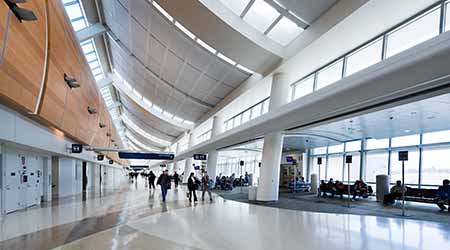 The Mineta San Jose International Airport's boiler replacement and central plant upgrade were the first projects in a series of HVAC and related upgrades that addressed energy efficiency.Mineta San Jose International Airport
The Mineta San Jose International Airport's boiler replacement and central plant upgrade were the first projects in a series of HVAC and related upgrades that addressed energy efficiency.Mineta San Jose International AirportAirport Fines Clear Skies to HVAC Savings
Part three of a three-part article on San Jose Airport’s energy efficiency upgrades
The airport’s central plant expansion was among the first in a series of upgrades to HVAC systems and components designed to bring additional energy savings to the organization. Among the most ambitious of these efforts was the replacement of rooftop package units.
“The biggest project as far as a renovation is that we acquired a building that American Airlines built in the late ‘80s,” Crowley says. “The building had 17 rooftop package units, so they had passed their expected useful life. Over the last four years, we’ve had an annual program to replace all of those units with standardized units between 15 tons and 25 tons.
“All the units were recently retrofit with BACnet controllers and the BAS was extended into this area so the 17 units are now interfaced and remotely accessed through the central plant main computer. This will not only improve energy efficiency but reduce delayed customer service, since the equipment is now fully integrated and controlled through the central BAS.”
Crowley and his staff also have tapped into the power of HVAC data to identify opportunities for energy savings.
“We’ve run some trend logs, and it turns out a couple of our air handlers were running 24/7 at times when we didn’t have occupancy,” he says. “They were able to see that on the trend log, go back in, and adjust the original scheduling from when we commissioned the building to meet the current occupant loads. We were able to reduce some of the electrical demands for the air handlers.”
In addition to HVAC system expansions and upgrades, the department’s HVAC preventive maintenance activities have uncovered opportunities to conserve energy.
“One of the major failures in mechanical systems is the outside air dampers, so we have a pretty good preventive maintenance program for making sure that all of the outside air returns and dampers are functional,” he says. “That’s an easy energy-saving return on investment. As a matter of fact, we found one in the last month that had a broken shaft on the motor. We were able to head that off in short order before we wasted a lot of time.
“On the electrical side, it was less than 5 percent that I was able to see from our energy consumption, so although it doesn’t look like we’ve done a whole lot on electrical reductions, it’s been a huge cost avoidance because electricity out here goes up by 6-8 percent a year. It’s a huge multi-million dollar burden every year on the budget.”
Working with the chiller manufacturer, Crowley is hoping that changes to the equipment will create still more opportunities for energy savings.
“The manufacturer did some eddy-current testing and the PMs,” Crowley says, adding that they also have a conversion kit for the chiller that allows them to put a variable-frequency drive on it so technicians can adjust the flow. “Right now, if we try to turn down the chiller’s capacity, it starves on condenser flow and shuts down the chiller. Basically, we don’t get any part-load advantages of running the 1,100-ton unit. So we’ll move forward with a new VFD and controller for that unit.”
The energy-efficiency gains that followed the boiler replacements have given Crowley and his staff the confidence that they are on the path greater savings.
Says Crowley, “Although we have not been able to single out the reductions in energy savings of the individual efforts, we have reduced consumption by 2 percent, while the cost per kilowatt-hour continues to increase.”
Related Topics:














